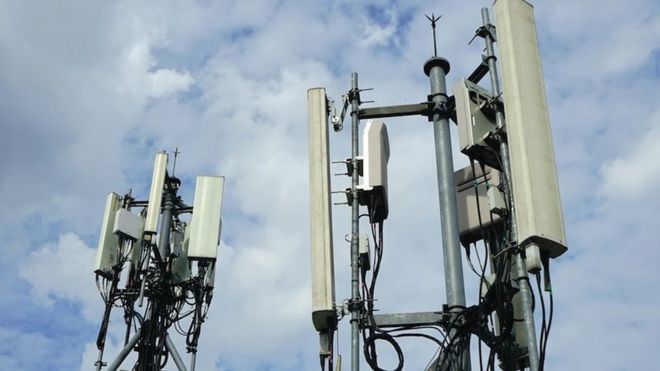 |
| GETTY IMAGES |
The fifth generation of cellular technology, 5G, is the next great leap in speed for wireless devices. This speed includes both the rate mobile users can download data to their devices and the latency, or lag, they experience between sending and receiving information.
5G aims to deliver data rates that are 10 to 100 times faster than current 4G networks. Users should expect to see download speeds on the order of gigabits per second (Gb/s), much greater than the tens of megabits per second (Mb/s) speeds of 4G.
"That's significant because it will enable new applications that are just not possible today," said Harish Krishnaswamy, an associate professor of electrical engineering at Columbia University in New York. "Just for an example, at gigabits per second data rates, you could potentially download a movie to your phone or tablet in a matter of seconds. Those type of data rates could enable virtual reality applications or autonomous driving cars."
Apart from requiring high data rates, emerging technologies that interact with the user's environment like augmented reality or self-driving cars will also require extremely low latency. For that reason, the goal of 5G is to achieve latencies below the 1-millisecond mark. Mobile devices will be able to send and receive information in less than one-thousandth of a second, appearing instantaneous to the user. To accomplish these speeds, the rollout of 5G requires new technology and infrastructure.
The new network
Since the earliest generation of mobile phones, wireless networks have operated on the same radio-frequency bands of the electromagnetic spectrum. But as more users crowd the network and demand more data than ever before, these radio-wave highways become increasingly congested with cellular traffic. To compensate, cellular providers want to expand into the higher frequencies of millimeter waves.
Millimeter waves use frequencies from 30 to 300 gigahertz, which are 10 to 100 times higher than the radio waves used today for 4G and WiFi networks. They're called millimeter because their wavelengths vary between 1 and 10 millimeters, where as radio waves are on the order of centimeters.
The higher frequency of millimeter waves may create new lanes on the communication highway, but there's one problem: Millimeter waves are easily absorbed by foliage and buildings and will require many closely spaced base stations, called small cells. Fortunately, these stations are much smaller and require less power than traditional cell towers and can be placed atop buildings and light poles.
The miniaturization of base stations also enables another technological breakthrough for 5G: Massive MIMO. MIMO stands for multiple-input multiple-output, and refers to a configuration that takes advantage of the smaller antennas needed for millimeter waves by dramatically increasing the number of antenna ports in each base station.
"With a massive amount of antennas — tens to hundreds of antennas at each base station — you can serve many different users at the same, increasing the data rate," Krishnaswamy said. At the Columbia high-Speed and Millimeter-wave IC (COSMIC) lab, Krishnaswamy and his team designed chips that enable both millimeter-wave and MIMO technologies. "Millimeter-wave and massive MIMO are the two biggest technologies 5G will use to deliver the higher data rates and lower latency we expect to see."
Is 5G dangerous?
Although 5G may improve our day to day lives, some consumers have voiced concern about potential health hazards. Many of these concerns are over 5G's use of the higher energy millimeter-wave radiation.
"There's often confusion between ionizing and non-ionizing radiation because the term radiation is used for both," said Kenneth Foster, a professor of bioengineering at Pennsylvania State University. "All light is radiation because it is simply energy moving through space. It's ionizing radiation that is dangerous because it can break chemical bonds."
Ionizing radiation is the reason we wear sunscreen outside because short-wavelength ultraviolet light from the sky has enough energy to knock electrons from their atoms, damaging skin cells and DNA. Millimeter waves, on the other hand, are non-ionizing because they have longer wavelengths and not enough energy to damage cells directly.
"The only established hazard of non-ionizing radiation is too much heating," Foster said, who has studied the health effects of radio waves for nearly 50 years. "At high exposure levels, radio frequency (RF) energy can indeed be hazardous, producing burns or other thermal damage, but these exposures are typically incurred only in occupational settings near high-powered radio frequency transmitters, or sometimes in medical procedures gone awry."
Many of the public's outcries over the adoption of 5G echo concerns over previous generations of cellular technology. Skeptics believe exposure to non-ionizing radiation may still be responsible for a range of illnesses, from brain tumors to chronic headaches. Over the years, there have been thousands of studies investigating these concerns.
In 2018, the National Toxicology Program released a decade-long study that found some evidence of an increase in brain and adrenal gland tumors in male rats exposed to the RF radiation emitted by 2G and 3G cellphones, but not in mice or female rats. The animals were exposed to levels of radiation four times higher than the maximum level permitted for human exposure.
Many opponents to the use of RF waves cherry-pick studies that support their argument, and often ignore the quality of the experimental methods or inconsistency of the results, Foster said. Although he disagrees with many of the conclusions skeptics have about previous generations of cellular networks, Foster agrees that we need more studies on the potential health effects of 5G networks.
"Everyone I know, including me, is recommending more research on 5G because there's not a lot of toxicology studies with this technology," Foster said.
Source: Livescience















0 comments:
Kindly comment here!